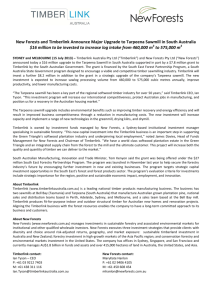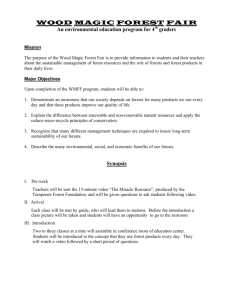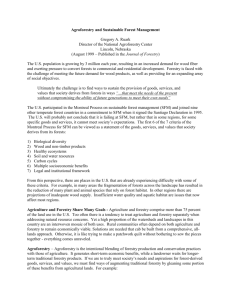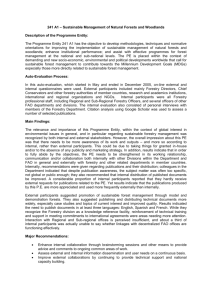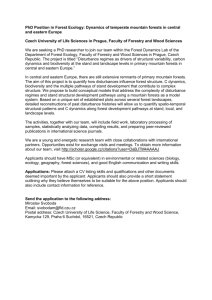National Association of Forestry Industries REDD Seminar ANU, 18
advertisement
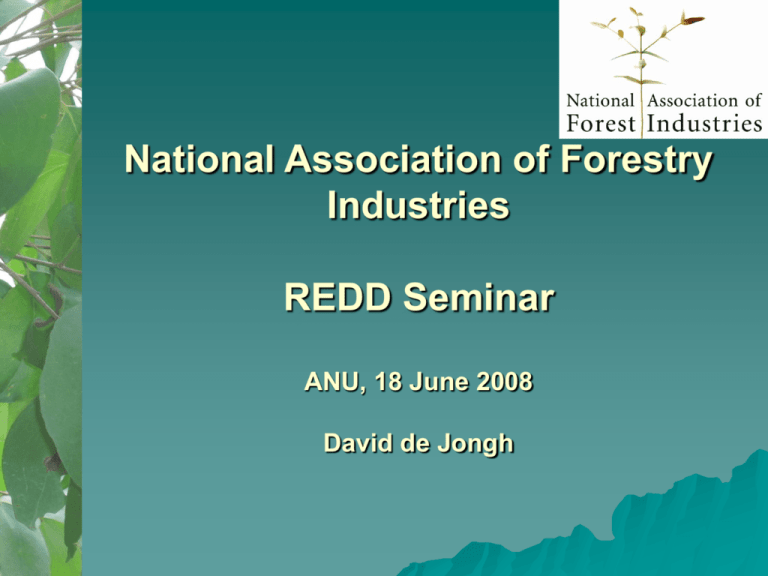
National Association of Forestry Industries REDD Seminar ANU, 18 June 2008 David de Jongh Presentation Outline Australia’s system of sustainable forest management The carbon profile of Australia’s forest industry Positioning the industry for an ETS Working with neighbouring countries on SFM and carbon abatement from forestry SFM Framework in Australia National Forest Policy Statement (1992) Regional Forest Agreements Plantations 2020 Vision State regulations, codes of practice etc Forest certification Forest Certification in Australia Two forest certification schemes in operation Australian Forestry Standard (AFS) - 8.67 million ha Forest Stewardship Council (FSC) – 533,000ha Forest Certification in Australia Ref (BRS 2008) Australian Forestry Standard (AFS) AFS is designed to suit Australian conditions and forest management frameworks AFS based on internationally recognised frameworks – ISO 14000 and Montreal C&I Developed through 3 year process by government, industry and environmental scientists Registered Australian Standard Internationally recognised through PEFC Carbon Profile of Australia’s forests SFM is critical for maximising carbon abatement from forestry Australia’s commercial forests are carbon positive providing significant carbon abatement towards national Kyoto targets Commercial forests (native forests and plantations) provide 44 million tonnes CO2 offsets towards Australia’s carbon accounts each year Carbon Profile of Australia’s forests Reduced land clearing and new plantations have been the main reason Australia is on track to meet its Kyoto targets Carbon emissions from land clearing declined from 70 million tonnes in 2002 to 53 million tonnes in 2005 Land clearing in Australia has occurred mainly for agriculture purposes but also urban development ‘Kyoto’ Plantations provide 20 million tonnes CO2 offsets each year Commercial Native Forests Australia’s commercial native forests offset 5.5% of national GHG emissions pa Commercial native forests provide 23 million tonnes CO2 offsets each year Wood production occurs within a permanent native forest estate meaning Australia is growing its native forest resources Change in resource base for commercial native forests Ref (BRS 2008) Plantations Australia is rapidly expanding its plantation estate – currently have 1.82 million ha Recent investment mostly through the private sector Currently expanding at around 75,000 hectares per year Delivering 20 million tonnes CO2 offsets each year On track to meet the 2020 Vision Target of 3 million hectares of plantations by 2020 – could provide 50 million tonnes CO2 offsets pa by 2020 Australia’s plantation expansion Ref (BRS 2008) Carbon benefits of wood products 14 Co ncrete slab 12 Steel sub-frame Tonnes CO2 10 8 B rick Ceramic tiles 6 Steel 4 Steel 2 A luminium Timber Timber Timber Timber Timber 0 Flo o r structure Flo o r co vering Wall 1 frame Ro o f frame Windo ws Construction component Ref (FWPRDC 2006) Carbon storage in wood products accounts for 5 million tonnes of CO2 offsets each year (DCC). Recognition in ETS is priority. An average Australian home built mostly from wood products saves around 25 tonnes of CO2 in the materials production process (CRC for Greenhouse Accounting) Carbon benefits of production forests and carbon storage in wood products Tonnes C / ha 600 500 400 300 200 100 0 0 20 40 60 80 100 120 140 160 180 200 Years Unharvested forest Harvested forest - no storage in w ood products Wood products included Ref (FWPRDC 2006) Wood Waste for Bioenergy Bioenergy from wood waste reduces CO2 emissions by 9599% for each MWh of electricity generated when compared to coal-fired electricity The use of currently available wood waste for bioenergy production in Australia has the potential to: reduce greenhouse gas emissions by around 3 million tonnes of CO2e each year; and supply renewable electricity to at least 400,000 houses (Ref www.nafi.com.au/bioenergy) Forest industry carbon abatement by 2020 Activity Est. CO2e offset/yr (million tonnes) Plantations 50 Native forests 23 Carbon in harvested wood products 5 Wood waste for renewable energy 3 Total 81 Forest Industry carbon abatement by 2020 90 80 Actual Projected 70 50 40 30 20 10 Native Forests Plantations Wood Products Bioenergy 20 20 20 18 20 16 20 14 20 12 20 10 20 08 20 06 20 04 20 02 20 00 19 98 19 96 19 94 19 92 0 19 90 Mt CO2e/yr 60 Total Ref (NAFI 2008) Australia’s GHG Emissions by Sector (2005) Ref (BRS 2008) National contribution to emissions reductions 900 800 Total abatement task 700 Mt CO2e 600 500 400 Forestry's contribution 300 200 100 0 1990 Business As Usual 2010 2020 Target 2020 - 20% below 1990 level Emissions abatement task with all forestry measures included Ref (NAFI 2008) ETS design and recognition of forestry’s contribution Recognition of the carbon positive nature of Australia’s forest industry will be critical in an ETS Encourage greater investment and maintain competitiveness Need to keep growing forest resources and using climate friendly wood products Inclusion of forestry under an ETS Comprehensive inclusion is sought by Australia’s forest industry – in line with Government objective of maximal coverage Not necessarily linked to agriculture – different accounting issues Critical to facilitate industry’s carbon full abatement potential Inclusion of forestry under an ETS Australia’s National Carbon Accounting System (NCAS) NCAS tracks carbon emissions and sinks from land based systems (forestry & ag) Australian Government working with international organisations and overseas governments to implement NCAS Objective is to allow carbon accounting of forests in these countries and prepare them for possible inclusion in an international ETS Australian Government has world leading position in relation to carbon accounting for forestry Working with neighbouring countries SFM is critical – delivers social, economic and environmental outcomes Forest certification is extremely valuable tool – particularly in developing countries NCAS important for carbon monitoring and compliance Thank You For more information visit www.nafi.com.au

